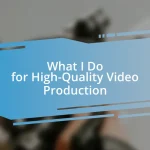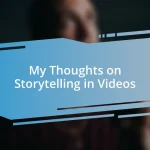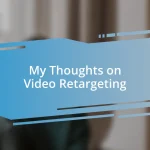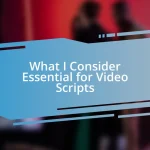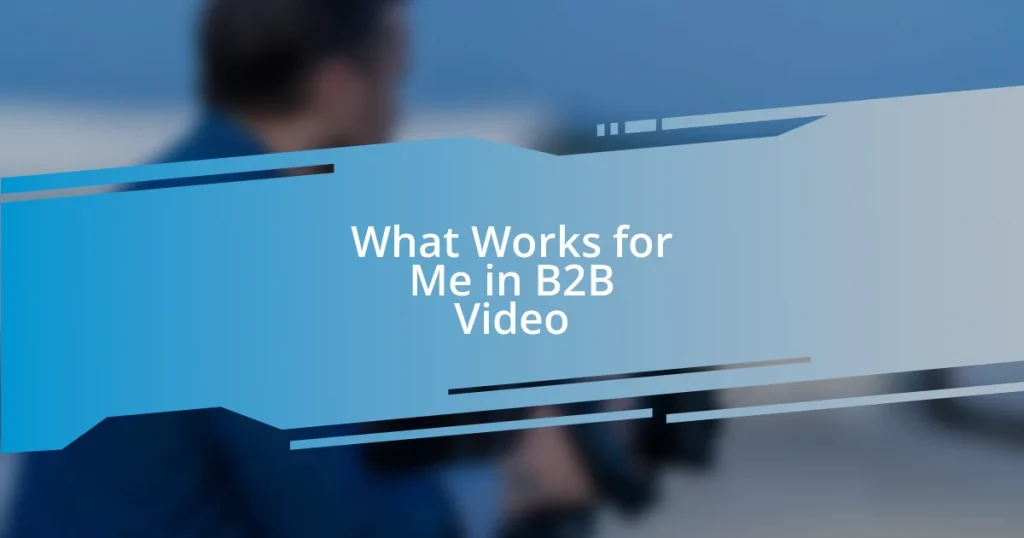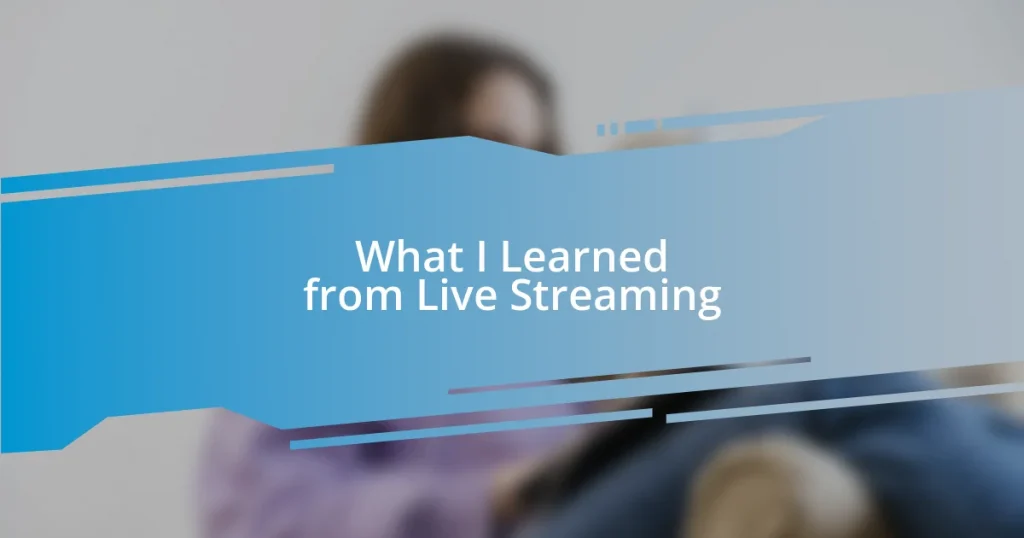Key takeaways:
- Understanding the narrative and emotional connection is crucial in video production, guiding all elements from scripting to visuals.
- Identifying and connecting with the target audience enhances storytelling, tailoring the message to resonate on a personal level.
- Effective distribution and marketing strategies, alongside collaboration with other creators, significantly boost a video’s reach and engagement.

Understanding Video Production Basics
Video production is a multifaceted process, and understanding its basics is crucial for anyone diving into this creative field. I remember my first project; I was so focused on the camera angles that I neglected the script. It’s amazing how the narrative drives everything – without it, the visuals can feel hollow.
Have you ever considered how different elements come together to create a compelling story? From scripting and storyboarding to lighting and audio, each phase adds richness to the final product. I often find myself revisiting the pre-production stage, realizing that planning is just as important as filming. After all, a well-thought-out plan can save countless hours during the shoot.
One aspect that many overlook is the emotional connection the visuals create with the audience. I often think about the power of colors and music – they evoke feelings that words sometimes can’t convey. This synergy between technical skills and emotional storytelling is what transforms an ordinary video into an engaging experience. How do you want your audience to feel when they watch your work? Reflection on this question can guide your production choices significantly.
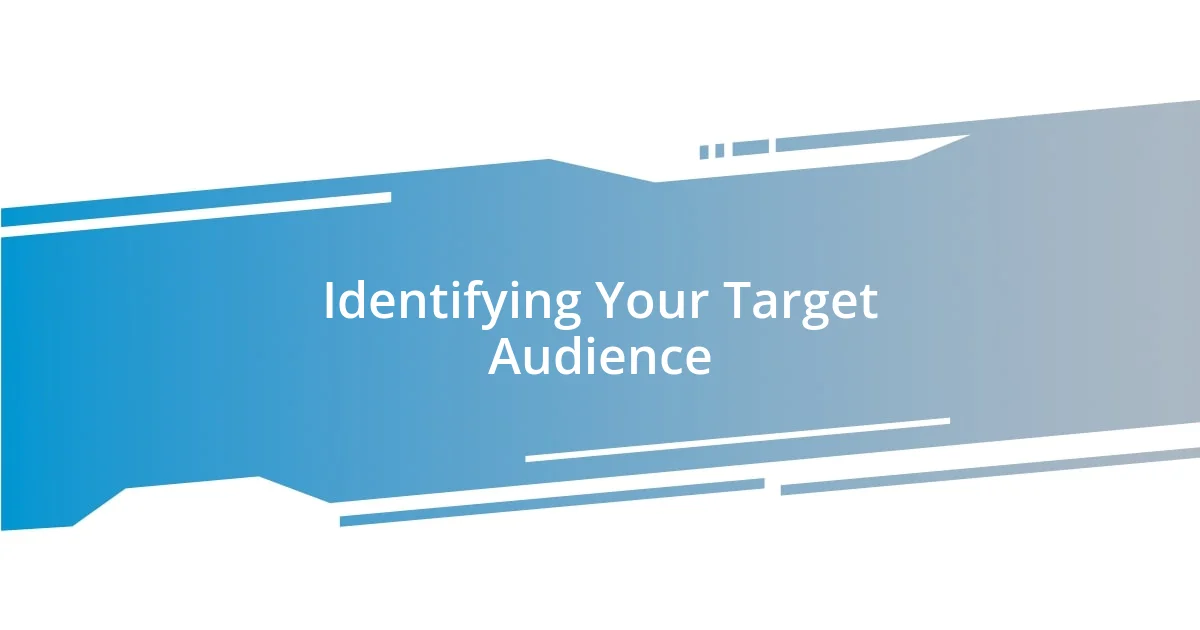
Identifying Your Target Audience
Understanding your target audience is a game changer in video production. I remember when I created a promotional video for a niche market; it was aimed at outdoor enthusiasts. I immersed myself in understanding their passions, interests, and even their pain points. What I discovered was that they wanted authenticity. This insight led me to include real-life experiences and testimonials, which resonated deeply with viewers.
Audience identification goes beyond demographics—it’s about connecting at a personal level. Once, I worked on a project targeting teenagers, and I realized that using popular trends and relatable language made all the difference. I engaged with them through social media polls, and their feedback was invaluable. Knowing what excites your audience can help tailor your message to grab their attention.
Ultimately, the key is to ask yourself who you’re speaking to. Are they looking for entertainment, information, or inspiration? Each audience has unique desires, and pinpointing these can lead to more effective storytelling. I often take time before every project to reflect on these questions, allowing me to create videos that truly resonate.
| Audience Insight | Impact on Video Production |
|---|---|
| Demographics (age, gender) | Guides style and tone of the video |
| Interests and Hobbies | Influences content themes |
| Emotional Triggers | Affects style and storytelling methods |
| Feedback Mechanisms | Shapes project revisions and enhancements |
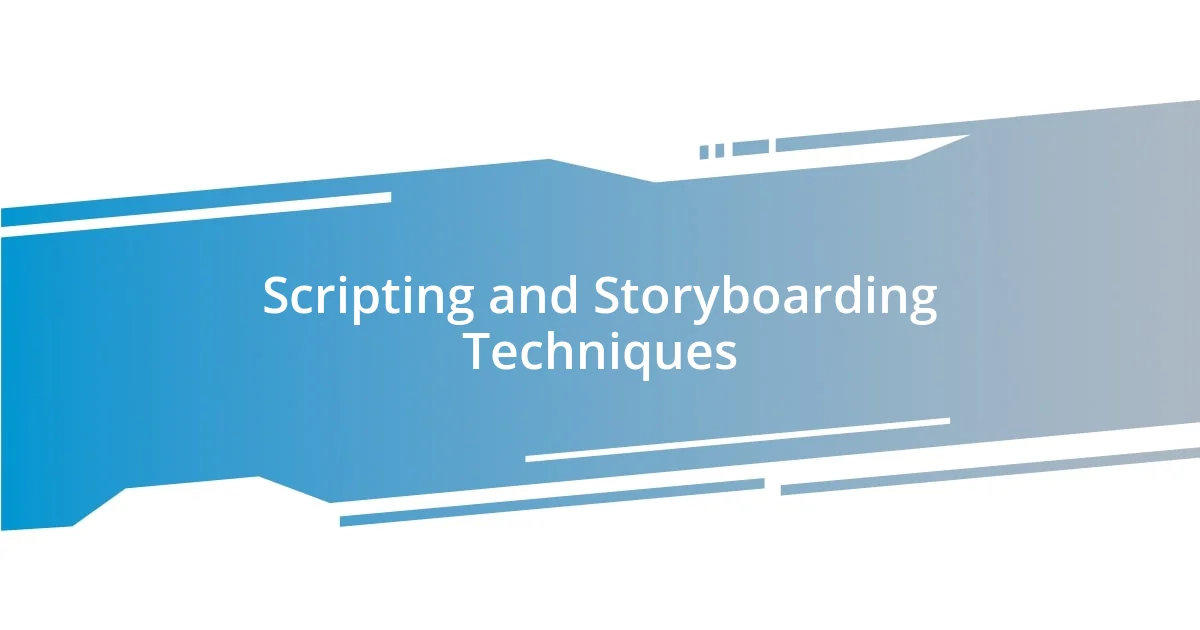
Scripting and Storyboarding Techniques
Scripting and storyboarding are foundational techniques that significantly shape video production. I’ve learned that an effective script is not just a series of lines; it’s the backbone of the entire video. For one project, I spent hours crafting a narrative that elegantly wove key messages into the dialogue. This became essential as I found that it not only helped convey the intended message but also engaged the audience emotionally. Storyboarding further enhances this process, allowing me to visualize the flow of the video, scene by scene. Each frame offers a glimpse of how the story unfolds, making it easier to identify gaps or areas for improvement before the cameras start rolling.
Here are some key techniques I value in scripting and storyboarding:
– Character Development: Invest time in creating relatable characters that drive the narrative.
– Clear Structure: Use a beginning, middle, and end to give your story a solid framework.
– Visual Elements: Incorporate notes about camera angles, lighting, and transitions directly in your storyboard to maintain a cohesive vision throughout.
– Emotional Beats: Identify moments in the script where you want to evoke specific feelings—this guides tone and delivery.
– Feedback Loop: Share early drafts of your script and storyboards with trusted colleagues; their insights can enhance your project tremendously.
The process of scripting and storyboarding forces me to think about each shot’s purpose, fostering a stronger connection to the final product. When I storyboarded a recent travel video, I included moments for reflection, paired with stunning visuals. This added depth and allowed viewers to feel as if they were experiencing the journey alongside me.

Choosing the Right Equipment
Choosing the right equipment for video production is a crucial step that can make or break your project. I remember my first project where I opted for a higher-end camera, thinking it would automatically elevate the quality. While it did enhance the visuals, the real game-changer was investing in good audio equipment. Poor sound can ruin even the most stunning visuals, so I’ve learned that a balance between visuals and audio is essential.
When selecting cameras, lenses, and microphones, it’s vital to align your equipment with your project’s goals. For instance, during a short film I worked on, I chose a camera with interchangeable lenses, allowing for creativity in capturing different perspectives. I was amazed at how the right lens could completely transform the mood of a scene. Have you ever considered how a wide-angle lens can create a sense of space, while a close-up can evoke intimacy? My experiences have taught me that thinking about these details in advance can significantly enhance storytelling.
Don’t forget to factor in lighting equipment too. I once shot a corporate interview at a venue with poor natural light, and without proper lights on hand, the quality suffered. Now, I always travel with portable LED lights, ensuring I’m prepared for any situation. Ultimately, it’s all about anticipating your needs and having the tools that will empower your vision. Selecting the right equipment isn’t just about brands or specs; it’s about understanding how each piece fits into your storytelling puzzle.
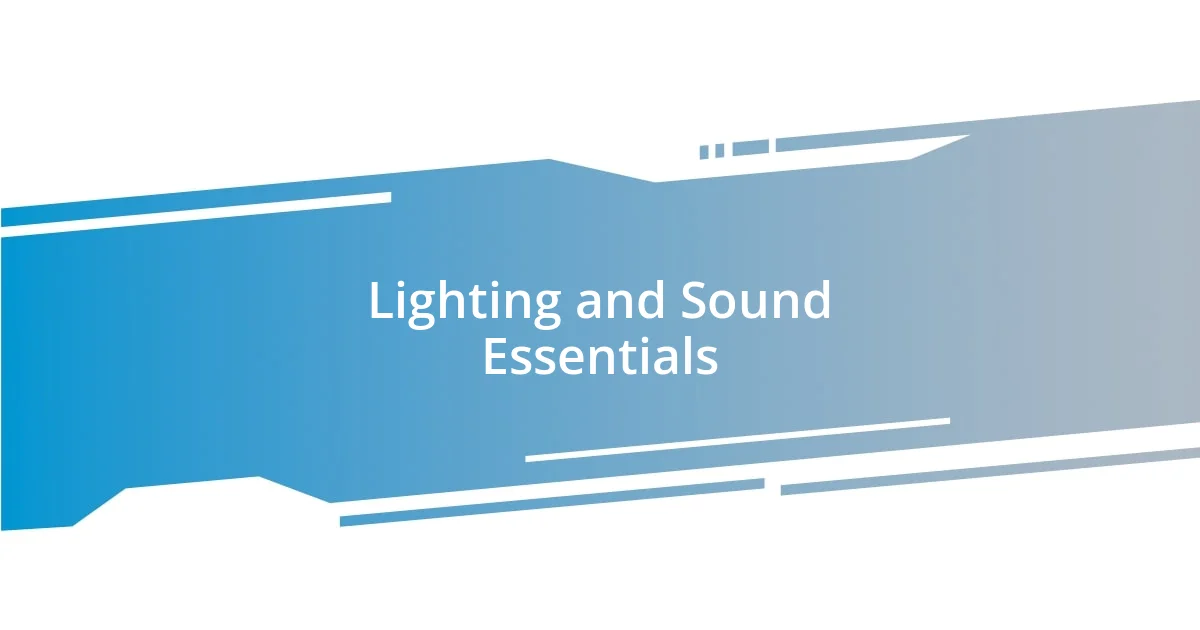
Lighting and Sound Essentials
Lighting can truly make or break your video production, and I can’t stress enough how important it is to get it right. I recall a project where I used harsh overhead lights that cast unflattering shadows on the subject’s face – it was a disaster! Since then, I’ve embraced softbox lights and diffusers, which create a more flattering, even light. Natural light is also a great ally; for a recent outdoor shoot, I timed it perfectly during golden hour. There’s something magical about that warm glow that just enhances every scene, don’t you think?
Sound is another crucial element that’s often overlooked by beginners. I vividly remember a documentary I worked on where ambient noise drowned out the interviews. The shaky audio left us scrambling during editing, and frankly, it was frustrating. Now, I always prioritize using quality microphones, and I’ve learned to record sound separately to ensure it’s crisp and clear. I find that a good lavalier mic can capture the nuances of speech beautifully. Plus, having a shotgun mic on hand has saved my bacon on more than one occasion!
As I continue to refine my craft, I realize that understanding sound design is fundamental to storytelling. I’ve started experimenting with adding soundscapes in post-production, adding depth to the narrative. For example, incorporating subtle background sounds can really transport the viewer, making them feel immersed in the story. How do you feel when you hear those sounds? It can transform your perception of the scene entirely. My journey has taught me that lighting and sound aren’t just technicalities; they are powerful tools that shape the emotional impact of my videos.
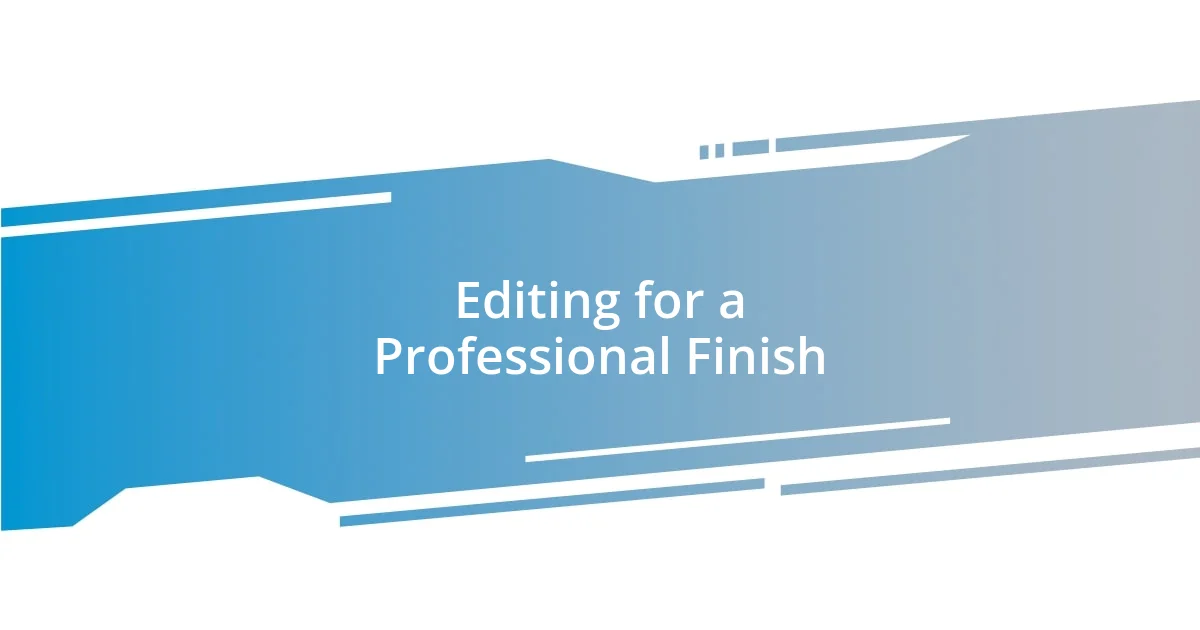
Editing for a Professional Finish
Editing can truly elevate a video’s overall quality, and I’ve learned that attention to detail in post-production is where the magic happens. I recall spending hours perfecting transitions and color grading on a short film. At first, I didn’t think it would make much of a difference, but the moment my friend saw the polished final cut, his jaw dropped. That’s when I realized that editing isn’t just about cutting footage; it’s about crafting an emotionally engaging experience. Have you ever watched a film where the editing took your breath away? It makes you appreciate the effort that goes into each cut.
I often find that pacing plays a critical role in storytelling. For example, while working on a corporate video, I experimented with the rhythm of cuts to match the narration’s energy. It transformed what could have been a dry presentation into an engaging story that kept viewers hooked. It’s fascinating how a well-timed cut can create suspense or laughter, depending on how you approach it. The edit room often feels like a creative playground where rhythm and flow come together to shape the narrative.
Color correction and grading are equally important; they can evoke specific emotions and set the tone for your video. I remember a travel vlog where I spent extra time enhancing vibrant colors to reflect the product’s energy. When I shared it, viewers commented on how they felt transported to that beautiful location. Isn’t it amazing how color can influence perception? With the right color palette, I found that I could essentially dictate the viewer’s mood and enhance their overall experience. Each adjustment can feel like a gentle nudge, guiding them through the story I’m trying to tell.

Distributing Your Final Product
Distributing my final product is an exhilarating yet strategic phase of video production. I remember my first time uploading a project to social media; it was a mix of excitement and anxiety. I quickly realized that choosing the right platform is essential—not all videos perform well everywhere. For instance, while Instagram is fantastic for short clips, YouTube is better suited for longer, more comprehensive storytelling. Have you ever wondered how your audience consumes content? Knowing their preferences can guide your distribution choices significantly.
I also find that marketing my video effectively is as crucial as the content itself. I once overlooked the power of a good thumbnail and title on YouTube. After my initial video underperformed, I rebranded it with a catchy thumbnail and a compelling title, leading to a surprising uptick in views. It’s incredible how those tiny changes can make such a big difference! Engaging descriptions and strategic tags can enhance discoverability, making viewers more inclined to click. What steps do you take to attract your audience in a crowded feed?
Finally, collaboration can significantly amplify a video’s reach. I recall partnering with a fellow creator who had an established audience that matched my target demographic. By sharing each other’s work, we not only expanded our reach but also built a sense of community. The energy and excitement of collaborating reminded me just how interconnected the video production world can be. Why work in isolation when you can thrive together?





